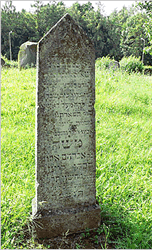Tracing Family Roots in Vilnius
Matt Gross
New York TimesJuly 16, 2008,
http://frugaltraveler.blogs.nytimes.com/2008/07/16/tracing-family-roots-in-vilnius/index.html
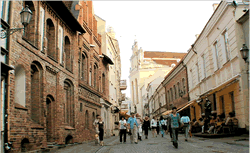
The Old Town in Vilnius, the capital of Lithuania.
In much of Europe, the Old Town is the only town that matters. Centuries-old stone houses, crammed into shoulder-width alleyways that swerve at random and wind uphill toward ancient churches dedicated to forgotten saints — this is, to many of us, what Europe is all about. But Old Towns often give me pause: Will the quaintness mask a lack of vitality? Is it a museum for tourists, or a place where locals live, work and play? And if the Old Town is boring, will the New Town — the less-densely populated, less charming sprawl outside the medieval city walls — be any better?
In Vilnius, the capital of Lithuania, I needn't have worried. Its Old Town is easily my favorite in Europe (sorry, Dubrovnik), a vast, fun web of alleys lined with elegant, straight-backed buildings that reminded me of Scandinavia. (Danes, I'm told, see them as very Russian.) Modern-day pilgrims — women sporting severely fashionable bangs, men who've mastered geek chic — flock to the 18th-century neo-Classical Vilnius Cathedral in the heart of the Old Town, not to pray but to hang out in the broad piazza. From there, they proceed up glossy Gedimino Prospect or cobblestoned Pilies Street, perhaps ducking under a low, concealed archway to grab a beer or three at one of the innumerable courtyard cafes.
It was in one such cafe that Regina Kopilevich sat across from me last Thursday and asked the question I had been waiting a lifetime to hear. Placing her hand atop the pile of papers in front of her and opening her clear blue eyes extra wide, she leaned forward and said, in slightly accented English, "Would you like to know your name?"
A simple question for most, but for the descendants of Eastern Europeans who immigrated to the United States at the turn of the last century, it can be a fraught mystery. Eager to assimilate, our ancestors shortened their unpronounceable alien monikers into names that would be easier on American ears and tongues. In the New World, the Old World was irrelevant.
For my family perhaps more than some. My great-grandparents were born in the 19th century, in the lands then referred to as Russia but that encompassed Poland, Lithuania, Belarus and beyond. And all somehow decided, as they embarked on new lives, never to discuss the past with their children. Growing up, I heard but a single story about our family: that my mother's grandfather owned a mill, and broke his neck when his beard got caught in its works. Other than that, I had only my name, Gross — which my elementary-school classmates kindly ensured I would never forget.
But my name, it turns out, is not Gross.
It's Grossmitz.
Video http://frugaltraveler.blogs.nytimes.com/2008/07/16/tracing-family-roots-in-vilnius/index.html
So began my week in Lithuania, an exploration of a culture that the Grand Tourists of the 18th century would have bypassed completely. Those wealthy Englishmen were preoccupied with the Greco-Roman world — the basis of their civilization — but these days we have to acknowledge a wider range of influences, whether they're African, Asian or, in my case, Eastern European Jewish.
And from the late 14th century up to World War II, Lithuania was the intellectual heart of the Eastern European Jewish world. Mostly free from the pogroms that afflicted them in neighboring lands, the Jewish community thrived, and Vilnius became a spiritual center, with 100 synagogues, almost 100,000 Jewish residents and, in the 18th century, a leader so wise and respected he is simply referred to as the Vilna Gaon — the Teacher of Vilnius.
Lithuania today is hardly the country my great-grandfather Morris Gross left a century ago. Now it's better known as a dynamic Baltic State, one of the successful countries — along with Estonia and Latvia —to emerge from the collapse of the Soviet Union. And it remains affordable. My accommodations — the Bernardinu B&B (5 Bernardinu Street, 370-5-260-8410, www.vilniusbandb.lt), a 400-year-old courtyard home just off hip Pilies Street — cost 160 litas a night, or about 46 euros at a fixed rate of 3.45 litas to the euro. (That's about $75, at 2.20 litas to the dollar.) And my restaurant meals never topped 35 litas, no matter how much well-brewed beer I consumed. The SIM card for my cellphone was the cheapest I've seen in 50 countries: a mere 4 litas.
Still, as I wandered the Old Town, I was watching every penny. Getting here was not cheap. With flights from Bucharest topping $450, I opted for the cheaper overnight train to Chisinau, Moldova (101.18 new Romanian lei, or $45 at 2.3 lei to $1), then Air Baltic flight 411 to Vilnius (101.70 euros, or about $162 at $1.62 to the euro). The 24-hour-long journey still totaled 130 euros — more than a day's budget.
More worryingly, I had to pay Regina, a multilingual researcher that I had hired to help me research my family roots. She'd worked 15 years at the Lithuanian State Historical Archives before going freelance and had come highly recommended by my distant cousin Rajmiel Odinec (on my mother's side), who appreciated her just-the-facts approach. Other guides, he warned, "embellish things and create stories" to please hopeful clients.
Regina's expertise, I learned shortly after learning my own name, would cost me 50 litas an hour. That did not include the 600 litas for the research she had done before my arrival, the extent of which she hadn't hinted at in the e-mails we'd exchanged. Along with an afternoon in the archives, and a day trip to visit my great-grandfather's hometown, I was looking at a minimum of 1,200 litas.
This was, uh, not exactly frugal, and as we rode a city bus (1.10 litas) to the Archives, my stomach was churning with anxiety. At what point would I have to tell Regina "no more"? And what kind of Grossmitz was I to economize at the cost of family history, to say that I could afford one uncle's name but not another's?
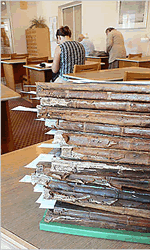
Nineteenth-century ledgers that recorded births, marriages and deaths.
I calmed down as soon as we entered the Archives' sunlit research room, and wavy-haired Regina produced a stack of ancient ledgers with pages crumbling to dust — the fruits of her expensive prep work. These were the records, kept by the Russian government that controlled the region in the 19th century, detailing births, deaths and marriages in the Jewish community of Marijampole, my great-grandfather Morris's hometown, about 86 miles west, near the Polish border.
The recorded history of the Grossmitz family begins on Feb. 9, 1829, with the marriage of Mowsha, son of Berko and Freyda Grossmitz, to Dobra, daughter of Berko and Sora Braskowicz. On Dec. 15 of that same year, their daughter Freyda was born, beginning a 20-year run of babymaking that produced Abram Itzko, Berko, Gabriel, Esther, Liba and Jankiel Judel.
Every fact, no matter how insignificant, was a nugget to be savored. Mowsha, potentially my great-great-great-grandfather, was a tailor! His nephew Chaim a shoemaker!
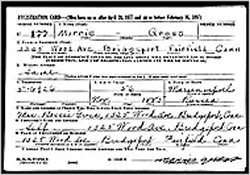
The draft card of Morris Gross.
We traced the lineage through the decades, inching closer to the 1885 birth of Moshe Grossmitz — that is, Morris Gross, who at the age of 16 would leave Marijampole and wind up in Bridgeport, Conn. But after 1874 the trail ran cold. For most of the next 25 years, the ledgers are missing, offering no insight into how Morris fit into the Grossmitz lineage or why he had left Marijampole in the first place. Regina had a theory: Morris Gross might have been fleeing conscription into the Russian army. If true, it would be a great irony, for the only document that cited Marijampole as his birthplace (recently found by my father on Ancestry.com) was his World War II draft card.
With all of these fresh facts at hand, I still knew little of the lives the Grossmitzes led. The Vilna Gaon Jewish State Museum (three locations; www.jmuseum.lt) provided some answers. Litvaks, as the Jewish Lithuanians were known, were traditionalists, seeking truth in the Torah and resisting assimilation, but many also joined the Haskala, or Jewish Enlightenment, and made significant marks as scientists, academics and artists. Between the wars, an art scene flourished, and many of the paintings and woodcuts from the so-called "Lost World" are on display at the museum's Center of Tolerance (10/2 Naugarduko Street).
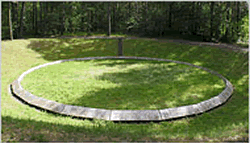
One of six pits, where Jews of Vilnius were killed by the Nazis and their Lithuanian collaborators.
The museum's Green House (12 Pamenkalnio Street) also shows quite graphically how 90 to 95 percent of Lithuania's 250,000 Jews were murdered. The Nazis invaded in June 1941 and in July, with the often eager aid of Lithuanians, began an organized slaughter of Jews, communists and the mentally ill. One chilling German document lists the number of people killed, day by day, village by village, sweeping across Lithuania from west to east. The second village on the list is Marijampole.
Eerier still is the Paneriai, the woods five miles southwest of Vilnius where almost all of the city's Jews were killed, their bodies dumped in six pits originally dug to store oil. Along with Regina — who generously agreed to halve her fee to 600 litas — I visited after the Archives and found nothing but calm woods. I tried to imagine the deathly scene, but kept getting distracted by the trill of birdsong and the sweetness of wild strawberry patches.
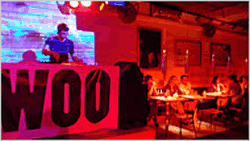
A Friday night at Woo, a basement cocktail lounge.
In fact, much of Vilnius was like that — so pleasant that I couldn't visualize the Old Town as the dismal ghetto of old. When I wasn't delving into my past, I was being shown a good time by my friend Jonas Oskinis, who led me from sidewalk cafes where we'd munch sliced pig ear (a traditional Lithuanian beer snack) and drink beers at Woo (22 Vilniaus Street, 370-5-212-7740, www.woo.lt), a cream-colored basement cocktail lounge that's a quintessential Vilnius-hipster hangout.
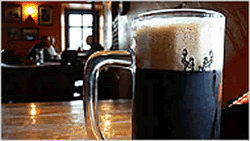
The house-brewed black beer at Busi Trecias.
For meals, we'd settle into the courtyard of the Vilnius Teachers' House (39 Vilniaus Street, 370-5-212-2603, www.kultura.lt) for expertly grilled trout (21 litas) or head to Busi Trecias (18 Totoriu Street, 370-5-231-2698), a cozy pub that serves a Lithuanian fry-up of potatoes, bacon, mushrooms and cream (a good hangover remedy if you indulge in too much of their excellent dark beer and apple-tinged brandy).
When my head cleared from the partying, I could see that very little of Jewish life had survived the twin assaults of the Holocaust and the Soviet era. Sabbath services at Vilnius's only remaining synagogue (39 Pylimo Street, 370-5-261-2523) drew about 25 elderly people, who prayed by the light of compact fluorescent bulbs. So instead, I caught the two-and-a-half-hour train (18 litas) to Marijampole.
It was a pretty little town of 50,000, with tree-lined boulevards and a few old brick buildings that were around in my great-grandfather's day: one stamped 1890, another a long, vaulted flower market. Weddings were in progress at two of the churches, and I watched one bride and groom drive off in a roadster, trailed by burly bikers.
On this sunny summer's day, the Sesupe River, which divides the town in half, was achingly beautiful. Ducks and children swam among the reeds, and shirtless men cast fishing lines into its slow currents. But upstream, in the crook of an oxbow — where a mare and her foal were grazing — was Marijampole's killing site, where some 7,000 to 8,000 Jews were murdered on Sept. 1, 1941, according to a town history written by former resident Joseph Rosin.
One of 11 surviving tombstones at Marijampole's old Jewish graveyard.
Across the river was what had been Marijampole's Jewish neighborhood, but now it was nothing but a New Town, dotted with slope-roofed wooden houses and damp-looking concrete towers from the Soviet era. Next to the main road, however, I found the remnants of Marijampole's Jewish cemetery. The 11 surviving tombstones had been set in a ring around a mound of earth covered in clover and daisies, and I walked from one to another, trying to make out the Hebrew inscriptions. Some were worn away to nothing, although I did spot a couple of Moshes.
Here, at least, I knew, was the resting place of my ancestors. For a century or more, they'd lived, prayed and died within a few miles of this tranquil spot. Until, of course, one of them had abandoned his family and departed for a distant land, with little money in his pocket and no idea what he'd find there.
I knew just how he felt.
